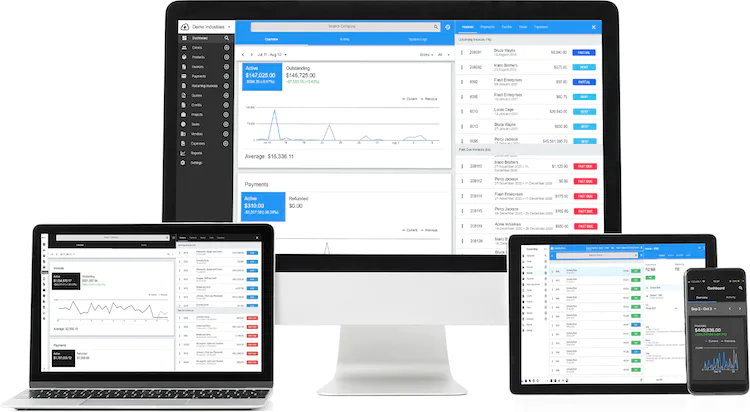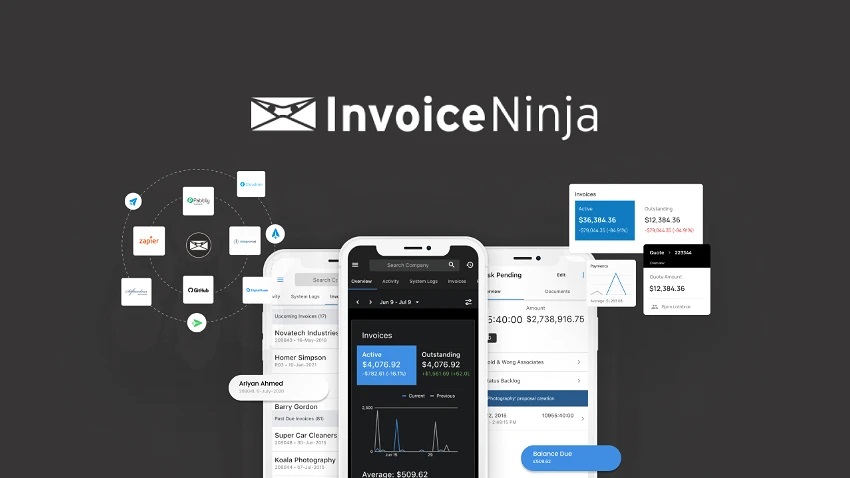To effectively manage a business, monitoring expenditures and acquisitions can range from straightforward to intricate, based on the employed systems.
Each year, companies are tasked with ordering an extensive range of products and services. This network of suppliers is responsible for providing everything necessary for your company to function and thrive. The primary mode of communication for these needs is through purchase orders (PO).
With a constant stream of orders and significant monthly spending on supplies, overseeing the PO process must remain a paramount concern.
Handling these processes manually can prove to be quite daunting. However, with the aid of Invoice Ninja – a top-notch invoicing software – businesses, regardless of their magnitude and locale, can streamline their everyday transactions, including but not limited to payments, project monitoring, bank reconciliations, stock management, and financial document generation.
Speaking of financial documents, invoice Ninja simplifies their creation, with the mere click of a button, be it expenses, bills, invoices, or purchase orders. In this post, we delve into the process of generating purchase orders through invoice Ninja.
A purchase order is a legally binding document that outlines the specific products or services that a company intends to obtain from a supplier. It acts as a formal offer to purchase items at a specified price and is a common tool used in the procurement process. Once accepted by the supplier, the PO becomes a binding contract between the buyer and the seller.
Key Elements of a Purchase Order
Purchase orders should be filled out clearly and concisely; the more information you supply to the provider, the better. To ensure that your purchase order covers all you need to obtain, always include:
✔️Purchase order number
✔️Product or service purchased
✔️Supplier name, Contact information, and billing address
✔️Buyer’s name, contact information, and Shipping address
✔️The order quantity, including the unit of measurement
✔️Line total
✔️Sales taxes
✔️The total cost
✔️The delivery date
✔️Shipping method
✔️Shipping terms and conditions
✔️Payment conditions
Creating a Purchase Order in Invoice Ninja
The process of creating a purchase order bears resemblance to that of creating an invoice. However, before initiating the creation of a purchase order, a vendor must be present within the system. This can be achieved by directly adding a vendor from the purchase order page, or by accessing the vendor tab.
Details
The Details panel contains essential information regarding the purchase order:
- Vendor – It is mandatory to select a vendor from the list for the purchase order to be applied to.
- Date – Automatically generated with today’s date, it simply denotes the date of the purchase order.
- Valid Until – If desired, you can specify an end date for the purchase order, limiting its validity and the duration for which it will be honored.
- Partial/Deposit – You may also choose to specify a required partial payment or deposit on the purchase order, along with its due date, separate from the overall due date for the full amount.
- Discount – You have the option to enter a discount amount for the purchase order, either as a percentage or a flat rate.
- Design – Select a template design from the available premade templates, or use your custom design. This can be done under the Settings tab in the desktop view of purchase orders.
Additional terms can be added to the purchase order in the Terms section.
Items
Here, a list of line items included in the purchase order can be viewed. Products can be added to the purchase order to bill the vendor. Each item on the list will have the following fields available:
- Product – The name of the product being applied.
- Description – A brief description of the item. Descriptions can include HTML or Markdown code formatting if enabled under Settings > Account Management.
- Unit Cost – The cost of a single product for the item.
- Quantity – The number of products to be multiplied by the unit cost for that item.
Notes
All these options are consolidated under one panel in the mobile layout, while in the desktop layout, they can be accessed through their respective tabs at the bottom of the purchase order screen:
- Purchase Order Terms – Describe any terms or restrictions that apply to the purchase order for your vendor.
- Purchase Order Footer – Include any text notes at the bottom of the purchase order. This is a nice place for minor disclaimers.
- Public Notes – Any text notes that you and your vendor can use to add detail or context to the purchase order. A nice place to keep service notes or a summary of work done for the vendor.
- Private Notes – Text notes that are not printed on the purchase order PDF and are not viewed by the vendor. These notes are only visible to admin portal users.
Documents
Upload images or documents to your purchase order for your vendor. These can be sent as attachments in the email to the vendor.
Why Use A Purchase Order?
Order placement can be executed through myriad means, whether your organization is small or large; one such method is utilizing purchase orders. A purchase order serves various purposes, including but not limited to the following:
a). Order tracking.
The status of your order can be tracked through a purchase order, from the time it is placed till its delivery. Keeping tabs on this information can aid in creating reports and analyzing spending patterns.
b). Efficient inventory management.
Many companies lack transparent visibility into their inventory, resulting in problems like inventory stockouts. Utilizing a purchase order system can assist in determining the required stock levels and when to replenish them, thereby optimizing operations and enhancing inventory management.
c). The requisition of goods or services.
Most often, a purchase order is employed to place an order for goods or services. This document delineates the items and their respective quantities that are required. Additionally, specific instructions such as delivery dates or payment terms can also be included for the supplier’s reference.
d). Reminder of the original order.
In the event of any changes to the initial order, a purchase order can serve as a reminder of the original request. This can prevent any confusion or miscommunication between your organization and the supplier. Without a purchase order in place, you run the risk of generating duplicate requests and incurring losses.
e). Improved company budgeting.
Accurate quantification of order quantities and associated costs beforehand is necessary before commencing a large project; this enables issuing precise purchase orders. This, in turn, facilitates more effective budgeting for such endeavors.
f). Acquisition approval.
While a purchase order does not establish a legally binding contract, it serves as an official request for goods or services. The supplier is unable to commence fulfillment of the order until they receive written confirmation from your organization, usually in the form of a purchase order acceptance.
Best practices in the purchase order process
We should ensure that some best practices in day-to-day or transactional purchasing practices are followed.
a). Ensure that all personnel participating in the purchase process are aware of the policies, procedures, and approval methods that must be followed.
b). Create an up-to-date panel of chosen suppliers who can give quality products at reasonable pricing and provide dependable services. This allows you to compare costs and terms of supply with the least amount of delay.
c). Enlist trusted providers of identical merchandise or services through a Master Agreement that outlines rates, escalations, and contractual terms. Verify the accuracy of product details and maintain comprehensive catalogs. This minimizes interactions and eliminates unnecessary documentation.
d). Cultivate strong partnerships with dependable suppliers to facilitate prompt resolutions to any issues that may arise. Adversarial relationships only impede productivity and bring about undue strain and expenses.
e). When feasible, adopt a centralized approach to purchasing information and ensure accessibility for all users. Utilize cutting-edge technology to optimize the purchase order process.
Identifying Common Purchase Order Issues:
1. Unyielding Suppliers: Suppliers may not automatically provide discounts or cover delivery costs unless specifically requested. However, most terms and conditions are negotiable.
2. Mistakes in Orders:
Quickly addressing mistakes with the supplier can effectively manage these errors.
3. Incorrect Quantities, Sizes, or Delivery Dates:
If errors are caught early, adjustments can be made to the PO before any activities take place.
Common Mistakes in Issuing POs:
4. Insufficient Financial Authority:
POs are often issued, whether verbally or in writing, without proper financial authorization. This frequent occurrence can have consequences for both the issuer and the budget.
Human error is often the root cause of purchasing problems. However, by maintaining clear communication and mutual understanding with your suppliers, most issues can be easily resolved.
Bottom Line
The purchase order serves as a crucial component in effectively managing a prosperous enterprise. Devoid of it, establishments may struggle with monitoring procurement responsibilities, tracking approvals, and maintaining budgetary supervision.
A commendable objective of any purchase order strategy is to strategically allocate resources to foster business expansion and scalability. By selecting a versatile software solution, there is a higher likelihood of facilitating sustainable and conscientious growth.
The purchase order procedure for smaller enterprises can be seamlessly streamlined with assistance from Invoice Ninja. Their invoicing software offers the convenience of customizing purchase orders for all supplier transactions.






